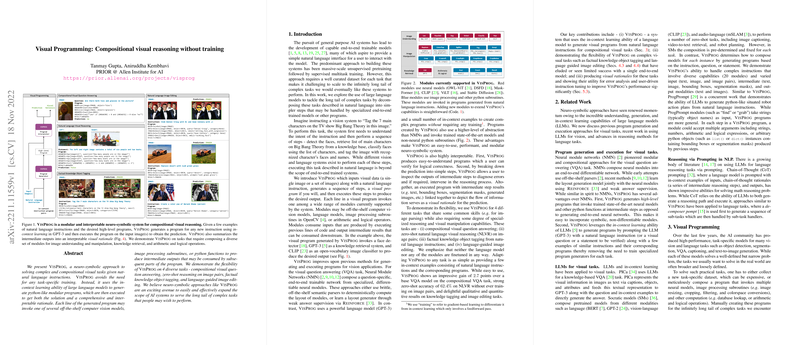Exploring Visual Programming for Compositional Tasks Using Neuro-Symbolic Methods
The paper "Visual Programming: Compositional visual reasoning without training" by Tanmay Gupta and Aniruddha Kembhavi from the Allen Institute for AI introduces an innovative approach to compositional visual reasoning without specific task training. The central contribution of this work is a neuro-symbolic system named VisProg, which leverages in-context learning capabilities of LLMs like GPT-3 to decompose complex natural language instructions into modular, interpretable programs. These programs integrate off-the-shelf computer vision models and image processing techniques to perform compositional reasoning over visual data.
Overview and Methodology
VisProg is designed to address the limitations of general-purpose AI systems that struggle with the vast array of complex tasks users might require. Traditional approaches rely on massive datasets and training, which are difficult to scale to new tasks. Instead, VisProg circumvents this by using pre-trained LLMs to generate programs from text instructions. These programs are highly modular, enabling the integration of various existing models and subroutines.
The system comprises several key components:
- Program Generation: Natural language instructions are used as input to generate a sequence of simple Python-like steps. Each step typically involves invoking specific vision or processing modules.
- Program Execution and Interpretation: The generated programs are executed within an interpreter that utilizes a predefined set of modules. These modules perform operations such as image recognition, data retrieval, and logic processing.
- Visual Rationale: VisProg provides an interpretable output by breaking down each step's input and output, offering insight into the decision-making process behind task execution.
VisProg demonstrates its capabilities across four diverse tasks: compositional visual question answering, zero-shot reasoning on image pairs, factual knowledge object tagging, and language-guided image editing. This flexible framework enables new tasks to be tackled merely by providing in-context examples, eliminating the need for explicit model retraining.
Empirical Evaluation
The paper provides empirical validation on several fronts:
- Compositional Visual Question Answering (GQA): VisProg is evaluated on the GQA dataset, where it outperforms baseline methods by decomposing complex questions into manageable modules, explored through various prompt strategies.
- Zero-Shot Reasoning on Image Pairs (NLVR): By reasoning over image pairs without explicit training, the system achieves a commendable accuracy, showcasing the potential of LLMs for handling multiple-image reasoning tasks.
- Factual Knowledge Object Tagging: Evaluating VisProg's capability to perform knowledge-driven tagging tasks with precision exemplifies the utility of integrating LLMs for factual retrieval as part of the visual reasoning process.
- Image Editing: This task illustrates VisProg's potential for practical applications beyond static feature recognition, such as using natural language for complex image manipulation.
Implications and Future Directions
The most significant implication of this work lies in its demonstration of LLMs' potential beyond language processing, extending into areas of visual reasoning and programming without the need for vast task-specific datasets. This positions neuro-symbolic systems as invaluable assets in expanding AI's applicability to numerous complex domains previously requiring intricate, manual configurations or extensive retraining.
Future work may focus on enhancing VisProg by integrating more sophisticated vision models and expanding the library of modules to cover a broader array of tasks. There is also the potential to improve the system's accuracy and interpretability by incorporating user feedback more dynamically. Furthermore, as LLMs evolve, their application in visual reasoning promises further improvements in handling ever more complex real-world scenarios.
In conclusion, this paper presents a compelling case for using modular neuro-symbolic approaches in AI, highlighting strengths in compositionality, flexibility, and interpretability, and heralding a promising direction toward more intelligent, versatile systems.
